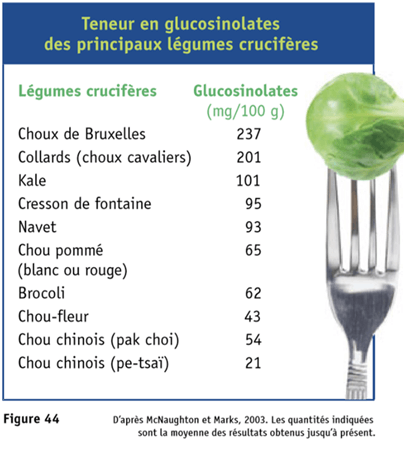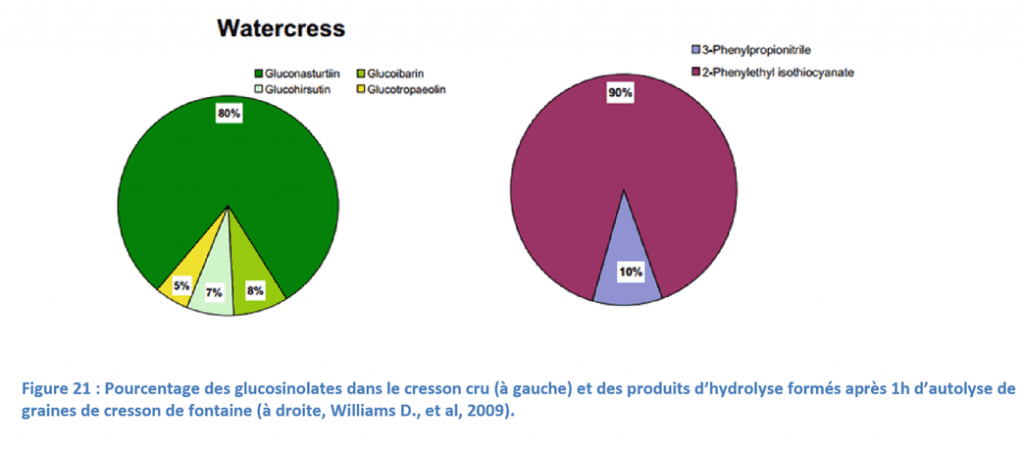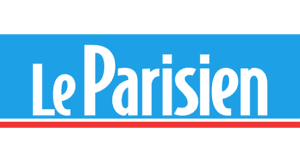Watercress : rich in glucosinolates
Of all the edible plants for humans, cruciferous vegetables are probably the ones that contain the greatest variety of molecules with anti-cancer properties. In addition to several polyphenols, cruciferous vegetables contain a group of compounds called glucosinolates. These molecules, particularly abundant in Brussels sprouts and cabbage (kale for example) and watercress, are also present in appreciable quantities in all cruciferous vegetables.
The importance of glucosinolates in the prevention of cancer by diet is not directly related to these molecules but rather to their ability to release two classes of compounds with very high anticancer activity, isothiocyanates (ITC) and indoles.
During the chewing of the vegetable and/or its digestion, the plant cells are broken up, which causes the different compartments present in the cells, normally separated from each other, to mix. Glucosinolates that were stored in one compartment of the cells are then put in contact with myrosinase, an enzyme present in another compartment; it is this contact that produces isothiocyanates (ITC) that are six times more bioavailable than the glucosinolates themselves and that have been shown to be anti-cancerous molecules.

Watercress is specific because it is the vegetable richest in a particular glucosinolate, gluconasturtiine and therefore also in the isothiocyanate derived from it, phenethylisothiocyanate (PEITC). This molecule is also found in horseradish, turnip and Chinese cabbage, but in much lower proportions.
Percentage of glucosinolates in raw watercress and hydrolysis products (after 1 hour) of watercress seeds (Williams D. et al, 2009)

Zeodrated watercress (SUPERCRESS) preserves the PEITC very well
Several factors are involved in the isothiocyanate contribution offered by the cruciferous vegetable :
Glucosinolates are highly soluble in water : cooking cruciferous vegetables for only ten minutes in water reduces the amount of glucosinolates present by half;
myrosinase activity is very sensitive to heat; in particular, cooking substantially reduces the amount of isothiocyanates that can be released once the vegetable is consumed.
From a practical point of view, cooking should be avoided and soaking of vegetables in water should be limited. In this respect, SUPERCRESS, which is dried shortly after cutting, without prior freezing and at low temperature, gives an excellent preservation result of PEITC.
LE PEITC, ANTI-CANCER MOLECULE, HAS BEEN THE SUBJECT OF 216 REFERENCE ARTICLES
BY MAPPING, TWO CATEGORIES OF THESE STUDIES APPEAR :
- those that analyse the ability of PEITC to inhibit proliferation or suppress the invasive effect of human cancer cells; they provide materials and open up possible therapeutic avenues;
- those that identify and measure the effects of PEITC on the elimination of potentially carcinogenic toxic substances; they place their contribution in the field of prevention and detoxification.
These studies include clinical studies on the effects of PEITC as found in watercress :
- in the first category, for example, the pilot study conducted by the University of Southampton in 2010
- in the second category is the work of Stephen HECHT, whose team works at the Masonic Cancer Center at the University of Minnesota.
STUDIES BY S. HECHT/ THE DETOX DIMENSION
Stephen Hecht is currently evaluating the effects of cress, an abundant source of PEITC, on the detoxification of environmental toxicants and carcinogens in a 350-person (placebo/double-blind) trial. All humans are exposed to benzene, acrolein, croton aldehyde and other related toxic and carcinogenic substances through their diet, polluted air and/or endogenous metabolic sources.
The interest of the subject was sufficient for the US National Cancer Institute to grant, in early 2018, a grant of $2 million to this clinical study project that Stephen HECHT’s team is currently deploying. The second half of the year allowed to specify the method of ingestion of watercress; the field takes place in 2019; the results will be known in two to three years.


